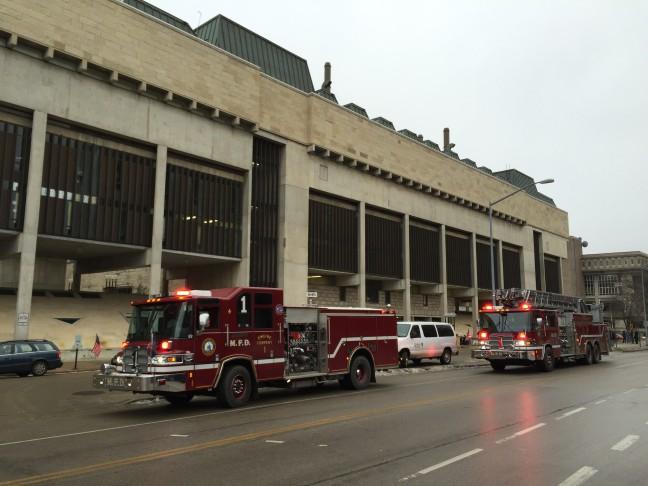The University of Wisconsin’s Mosse Humanities Building is almost universally criticized by the university’s students. Sometimes referred to as a prison because of its unattractive metal, concrete exterior and dim interior lighting, Humanities can reasonably be declared one of the worst buildings on UW’s campus — not to mention it is “no longer functional,” according to Chancellor Rebecca Blank.
But with the recent news of the university’s plans to build a College of Letters & Science building and renovate the Humanities Building moving forward, it is important to look at why these projects are so desperately needed in the first place.
Humanities was initially created because of minimal space in the Department of History, which at the time was located at the bottom of Bascom Hill. According to the Department of History, the building housed 23 professors and 34 TAs that were forced to share only 16 offices. The other liberal arts departments at UW also began to grow during this time as enrollment steadily grew.
Where’s the Wi-Fi?: UW must provide more reliable internet to students
By 1950, UW’s fall enrollment had grown to over 15,000 students. The school realized the need to accommodate its growing student population. The Humanities Building was designed with the intention of not only expanding the Department of History’s floor plan but also to house the Departments of Music and Art. The thought was to create a commonplace for liberal arts students to have the bulk of their classes in.
But the building has fallen short of that goal. Key humanities departments, such as English and Language Arts, are still spread across campus. Enrollment has only continued to rise since the mid-1900s. The undergraduate enrollment alone has reached 47,936 in the fall of 2021 and most students have to spend time in the Humanities Building to fulfill their graduation requirements.
What had once been considered plenty of space for the four departments housed in the Humanities Building now feels cramped, with a student population over three times the size of what it was 70 years ago.
Another problematic aspect of Humanities is rooted in the timing of its construction. The building was constructed in the 1960s, during a period of intense student uprisings. A rumor falsely contended the building’s layout was specifically designed to deter mass student protests because of its small corridors and to ease police intervention. Should a crowd form, some thought the angled exterior walls would make scaling the building much easier for law enforcement.
Though this has been disproven by the director of campus planning, the conspiracy continues to circulate through the school’s student body about how their right to assembly could be threatened by the building’s architectural design.
The building is also perplexing from a logistical standpoint. The Humanities Building spans an entire city block, making it one of the biggest buildings on campus. Its floor plan is a strange contrast of small hallways and grand outdoor passageways, large lecture halls and cramped music classrooms, modern rooms with walls of windows and basement classes with fluorescent bulbs being the only source of light. While each individual aspect of the Humanities Buildings is unique and architecturally innovative, it is the combination that highlights its confusing nature.
Lastly, and perhaps most notably, is the degradation of the building itself. The concrete walls were controversial amongst students for their unappealing aesthetic and cold temperatures in the winter. But with clearly visible rusting and dirt, the material has also become a health concern.
It’s not easy out there: A student guide to navigating off-campus housing market
Leaking windows are another sign of deterioration. Rain on stormy days and cold air in the dead of winter are impossible to keep out of classrooms in the building’s current condition. Last spring, the northwest section of the building was even forced to shut down because of structural concerns found in an engineering review.
For these reasons and many more, it is time for change. UW has recognized this alongside their students and faculty and have announced plans to tear down Humanities to construct a new L&S building across from the School of Business. With a recent $20 million donation, construction for “Irving and Dorothy Levy Hall” is set to begin in 2023 and be completed in 2025.
Dean of the College of Letters and Science Eric Wilcots said in a statement the new building “will modernize the student learning experience and build research connections on campus, better serving the needs of our growing undergraduate population.”
UW psychedelic research shows promise for medicine, must proceed with caution
The building will be better suited for modern technology — something that Humanities has been sorely lacking. It will join UW’s other recent construction projects in efforts to become more environmentally sustainable, from energy efficient lighting and heating to more eco-friendly building materials — all features that are a needed change from Humanities’ environmentally abrasive concrete foundations.
It will also focus on a more open floor plan in classrooms and retire the traditional, cramped lecture halls the building has advertised for decades. Campus Planning Director Gary Brown said to The Cap Times that the goal is to increase the flexibility of what these classrooms can be used for. Because of the proposed size of Irving and Dorothy Levy Hall, the 10 humanities departments currently spread across eight facilities will consolidate, therefore increasing academic efficiency.
With a new building on the horizon, it is finally time to say goodbye to the Humanities Building and all of its problematic qualities to welcome a novel frontier for UW as a whole.
Fiona Hatch ([email protected]) is a freshman studying political science and international studies.














